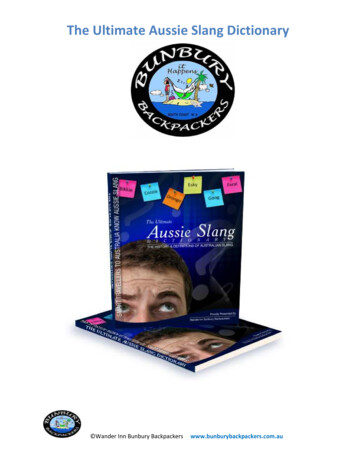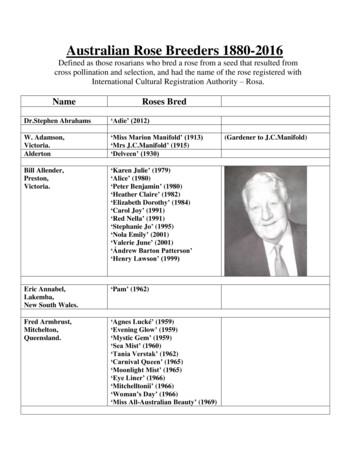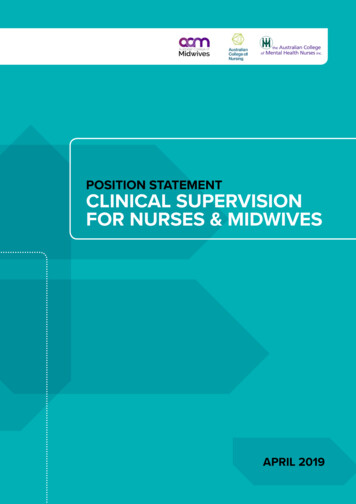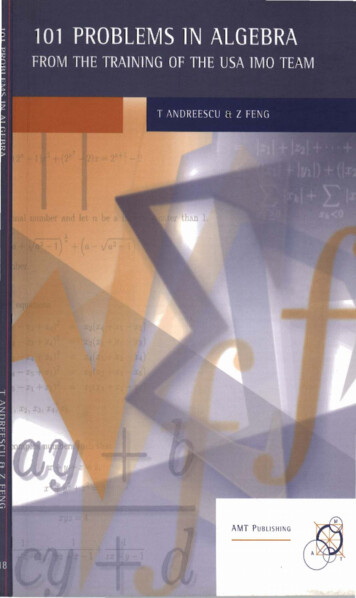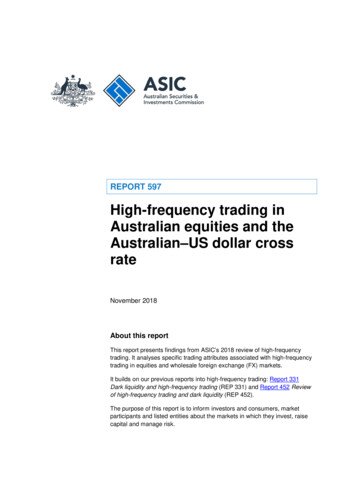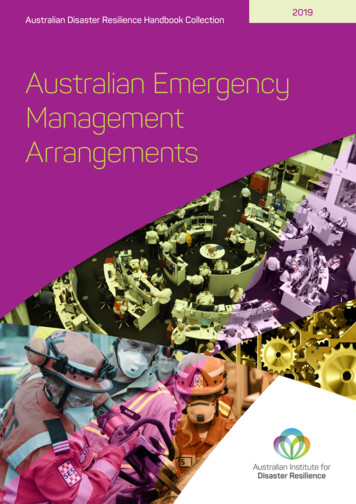
Transcription
Australian Guidelines for the Preventionand Control of Infection in Healthcare
DescriptionThe Guidelines provide a nationally accepted approach to infection prevention and control, focusing on coreprinciples and priority areas for action. They provide a basis for healthcare workers and healthcare facilities todevelop detailed protocols and processes for infection prevention and control specific to local settings.This approach is underpinned by a risk-management framework to ensure the basic principles of infectionprevention and control can be applied to a wide range of healthcare settings including hospitals, day procedureunits, office‑based practice, long-term care facilities, remote area health services, home and community nursing andemergency services. It is recognised that the level of risk may differ according to the different types of facility andtherefore some recommendations should be justified by risk assessment. When implementing these recommendationsall healthcare facilities need to consider the risk of transmission of infection and implement according to their specificsetting and circumstances.The evidence base for the Guidelines addresses the highest level of risk of infection transmission in the healthcaresetting, and has predominantly been drawn from the acute-care setting. The recommendations should be read in thecontext of the evidence base and the advice on the practical application of the recommendations.Sponsors/FundingThe Australian Guidelines for the Prevention and Control of Infection in Healthcare were co-funded by the NationalHealth and Medical Research Council and Australian Commission on Safety and Quality in Health Care.Publication detailsPublication title: Australian Guidelines for the Prevention and Control of Infection in HealthcarePublished:May 2019Publisher:National Health and Medical Research CouncilNHMRC Publication Reference:CD34Online version (interactive app):www.magicapp.orgOnline version (PDF):www.nhmrc.gov.auISBN Online:978-1-86496-028-0Suggested citation: Australian Guidelines for the Prevention and Control of Infection in Healthcare,Canberra: National Health and Medical Research Council (2019).Copyright Commonwealth of Australia 2019All material presented in this publication is providedunder a Creative Commons Attribution 4.0 Australialicence (www.creativecommons.org.au), with theexception of the Commonwealth Coat of Arms,NHMRC logo and content identified as being ownedby third parties. The details of the relevant licenceconditions are available on the Creative Commonswebsite (www.creativecommons.org.au), as is the fulllegal code for the CC BY 4.0 AU licence.AttributionCreative Commons Attribution 4.0 Australia Licence is astandard form license agreement that allows you to copy,distribute, transmit and adapt this publication providedthat you attribute the work. The NHMRC’s preferenceis that you attribute this publication (and any materialsourced from it) using the following wording: Source:National Health and Medical Research Council.Use of imagesUnless otherwise stated, all images (including backgroundimages, icons and illustrations) are copyrighted by theiroriginal owners.Contact usTo obtain information regarding NHMRC publications or submit a copyright request, contact:E: nhmrc.publications@nhmrc.gov.auP: (02) 6217 9000
ContentsContentsSummary of recommendations 1.Introduction 2. Basics of infection prevention and control 110142.1Infection prevention and control in the healthcare setting 142.2Overview of risk management in infection prevention and control 202.3A patient-centred approach 242.3.126Involving patients in their care 3. Standard and transmission-based precautions 3.128Standard precautions 293.1.129Hand hygiene 3.1.2 Use and management of sharps, safety engineered devices andmedication vials 483.1.33.23.33.43.5Routine management of the physical environment 553.1.3.171Emerging disinfection methods 3.1.4Reprocessing of reusable medical devices 833.1.5Respiratory hygiene and cough etiquette 903.1.6Aseptic technique 913.1.6.1 Example of an Aseptic Technique: Aseptic Non-TouchTechnique (ANTT ) 913.1.7Waste management 963.1.8Handling of linen 97Transmission-based precautions 973.2.1Application of transmission-based precautions 983.2.2Contact precautions 1003.2.3Droplet precautions 1063.2.4Airborne precautions 112Personal protective equipment 1213.3.1136Other items of clothing Management of multi-resistant organisms and outbreak situations 1363.4.1Multi-resistant organisms 1373.4.2Outbreak investigation and management 1493.4.2.1156Infection control strategies to contain an outbreak Applying standard and transmission-based precautions during procedures 1603.5.1Taking a risk-management approach to procedures 1613.5.2Invasive medical devices 1623.5.2.1164Indwelling urinary devices National Health and Medical Research CouncilAustralian Guidelines for the Prevention and Control of Infection in Healthcareiii
Contents3.5.33.5.2.2 Intravascular access devices 1673.5.2.3 Ventilation 1733.5.2.4 Enteral feeding tubes 175Surgical procedures 1763.5.3.1177Preventing surgical site infections (SSIs) 4. Organisational support 4.14.24.34.44.54.6Management and clinical governance 1814.1.1Clinical governance in infection prevention and control 1814.1.2Roles and responsibilities 1834.1.3Infection prevention and control program 1854.1.4Risk management 1864.1.5 Taking an organisational systems approach to infection preventionquality and safety 191Staff health and safety 1934.2.1Health status screening and immunisation 1944.2.2Exclusion periods for healthcare workers with acute infections 1994.2.3Managing exposures to occupational hazards 2034.2.4Healthcare workers with specific circumstances 2044.2.5Exposure-prone procedures 205Education and training 2104.3.1212Education strategies Healthcare associated infection surveillance 2134.4.1Role of surveillance in reducing healthcare associated infection 2134.4.2Types of surveillance programs 2144.4.3Data collection and management 2154.4.4 Outbreak surveillance 2164.4.5Disease surveillance in office-based practice 2174.4.6Notifiable diseases 217Antimicrobial Stewardship 2184.5.1Antimicrobial resistance in Australia 2194.5.2Antimicrobial stewardship programs 2214.5.3Antimicrobial stewardship surveillance methods 222Influence of facility design on healthcare associated infection 2244.6.1 Mechanisms for influencing healthcare associated infection throughenvironmental design 2245. APPENDIX 1: Case studies and examples 5.1180230Risk-management: Case study for hand hygiene in a neonatal intensive care unit 2315.2 Risk-management: Case study for glove use, hand hygiene and seasonalinfluenza vaccination in an office‑based practice 232National Health and Medical Research CouncilAustralian Guidelines for the Prevention and Control of Infection in Healthcareiv
Contents5.3Example: Education in practice - hand hygiene 2335.4 Risk-management: Case study for the prevention of needlestick injuryduring surgery at a tertiary referral hospital 2345.5Risk-management: Case study for spills management in a busy paediatric ward 2355.6Risk-management: Case study for reprocessing of instruments in a dental practice 2365.7Risk-management: Case study for Klebsiella pneumoniae sepsis in a neonatal unit 2375.8Risk-management: Case study for influenza in a long-term care facility 2385.9Risk-management: Case study for M. tuberculosis 2405.10 Risk-management: Case study for M. tuberculosis amongimmunocompromised patients attending outpatient services 2415.11 Examples of how to perform aseptic technique 2435.12 Risk-management: Case study for norovirus outbreak in a long-term care facility 2465.13 Risk-management: Case study for management of confirmed case ofcarbapenemase-producing Enterobacterales (CPE) 2475.14 Risk Management: Case study for vancomycin-resistant enterococci (VRE)outbreak in a large tertiary-care referral hospital 2495.15 Risk-management: Case study for infection prevention during renovation ofemergency department 2506. APPENDIX 2: Supplementary information 7.2516.1Recommended routine cleaning frequencies 2516.2Checklist of standard precautions for procedures 2576.3Use of standard and transmission-based precautions 2586.4Type and duration of precautions for specific infections and conditions 2596.5Collection of pathology specimens 2816.6Allowing animals into healthcare facilities 2826.7Mechanisms of antibacterial action of antiseptics and disinfectants 2826.8Summary table of relevant infection prevention and control resources 2846.9Research gaps 287APPENDIX 3: Process report 7.1Membership and Terms of Reference of the Advisory Committee 2892978. Glossary 3019. Abbreviations and acronyms 31010. Index 312References 330National Health and Medical Research CouncilAustralian Guidelines for the Prevention and Control of Infection in Healthcarev
ContentsList of tables and figuresTablesTable 1. Risk evaluation matrix 24Table 2. Additional situations when hand hygiene should be performed 32Table 3. Examples of sharps associated with sharps injuries in healthcare settings 48Table 4. Summary of processes for appropriate use of devices 50Table 5. Methods for evaluating environmental cleanliness in healthcare facilities 61Table 6. Appropriate processes for managing spills 67Table 7. Categories of items for patient care 84Table 8. General criteria for reprocessing and storage of equipment andinstruments in healthcare settings 88Table 9. Class of device and associated reprocessing method 89Table 10. Steps in respiratory hygiene and cough etiquette 90Table 11. Selection of Standard-ANTT or Surgical-ANTT for specific procedures 94Table 12. State and territory resources for waste management 96Table 13. Properties of different types of mask 115Table 14. Putting on and removing PPE 123Table 15. Recommended use and characteristics of aprons/gowns 126Table 17. Types of surgical masks 129Table 18. Selection of glove type 133Table 19. Suggested approach to routinely screening for MRSA 139Table 20. Suggested approach to routinely screening for VRE and MRGN 140Table 21. Steps in an outbreak investigation 151Table 22. Developing and testing an hypothesis for an outbreak 154Table 23. Level of risk to patients from different types of procedures 161Table 24. Process for urethral catheter insertion and maintenance 166Table 25. Minimising the infection risk to patients from intravascular accessdevices by device type 168Table 26. Summary of strategies for preventing VAP 174Table 27. Summary of processes for using enteral feeding tubes 175Table 28. Summary of perioperative processes 177Table 29. Summary of intraoperative processes 178Table 30. Summary of postoperative processes 179Table 31. Recommended vaccinations for all healthcare workers 195Table 32. Staff exclusion periods for infectious illnesses 199Table 33. EPPs and non-EPPs in specific areas of clinical care 206Table A1.1. Case study for hand hygiene in a neonatal intensive care unit 231Table A1.2. Case study for glove use, hand hygiene and seasonal influenzavaccination in an office-based practice 232Table A1.3. Case study for the prevention of needlestick injury during surgery ata tertiary referral hospital 234Table A1.4. Case study for spills management in a busy paediatric ward 235National Health and Medical Research CouncilAustralian Guidelines for the Prevention and Control of Infection in Healthcarevi
ContentsTable A1.5. Case study for reprocessing of instruments in a dental practice 236Table A1.6. Case study for Klebsiella pneumoniae sepsis in a neonatal unit 237Table A1.7. Case study for influenza in a long-term care facility 239Table A1.8. Case study for M. tuberculosis 240Table A1.9. Case study for M. tuberculosis among immunocompromised patientsattending outpatient services 242Table A1.10. Aseptic technique for peripheral and central access IV 243Table A1.11. Aseptic technique for wound care 245Table A1.12. Case study for norovirus outbreak in a long-term care facility 246Table A1.13. Case study for management of confirmed case of CPE 248Table A1.14. Case study for VRE outbreak in a large tertiary-care referral hospital 249Table A1.15. Case study for infection prevention during renovation of emergencydepartment 250Table A2.1. Level of risk 251Table A2.2. Minimum cleaning frequency 252Table A2.3. Standard precautions for procedures 257Table A2.4. Use of standard and transmission-based precautions 258Table A2.5. Precautions for specific infections and conditions 259Table A2.6. Active agents in antiseptics and disinfectants 283Table A2.7. Infection prevention and control resources 284Table A3.1. Levels of evidence in literature reviews 294Table A3.2. Comparison of FORM and GRADE recommendation descriptors 295Table A3.3. Independent expert review participants 297Table A3.4. Members of the Infection Control Guidelines Advisory Committee 298FiguresFigure 1. The chain of infection transmission 15Figure 2. Factors influencing healthcare associated infection 16Figure 3. Risk management 21Figure 4. Risk analysis matrix 22Figure 5. Importance of hand hygiene 30Figure 6. 5 moments for hand hygiene 31Figure 7. Cleaning requirements for routine environmental cleaning 56Figure 8. Processes for routine cleaning and product choice 60Figure 9. Process for fitting and removing a P2 respirator 118Figure 10. Personal protective equipment and maximal barrier precautions forinsertion of CVCs, PICCs or guidewire exchange (cap, surgical mask(covering mouth and nose), sterile gown, sterile gloves and sterile fullbody drape) 173Figure 11. Calculating the level of risk 196Figure 12. Risk score 197Figure 13. Overall risk rating 197Figure 14. Antimicrobial use in Australian hospitals and other countries 220Figure 15. Antimicrobial use in the community in Australia and in other countries 220National Health and Medical Research CouncilAustralian Guidelines for the Prevention and Control of Infection in Healthcarevii
Summary of recommendationsSummary ofrecommendations3.1.1Hand hygieneStrong Recommendation1.It is recommended that routine hand hygiene is performed: before touching a patient before a procedure after a procedure or body substance exposure risk after touching a patient after touching a patient’s surroundings.Hand hygiene must also be performed before putting on gloves and after the removalof gloves.Practice Statement2. It is good practice for patients to perform hand hygiene and be educated about thebenefits of hand hygiene for infection prevention and control.Patients should be involved in hand hygiene and offered the opportunity to clean theirhands when appropriate, including before meals and after using the toilet, commode orbedpan/urinal. Patient preferences for hand hygiene products may differ, and theyshould be provided with the option of alcohol-based hand rubs, hand wipes or access tohand wash basins, based on any specific needs.Strong Recommendation3. It is recommended that alcohol-based hand rubs that contain between 60% and 80%v/v ethanol or equivalent should be used for all routine hand hygiene practices.Statutory Requirement4. It is good practice that alcohol-based hand rubs that meet the requirements ofEuropean Standard EN 1500 are used for all routine hand hygiene practices.Note: This advice aligns with mandatory requirements as set by Australia’s Therapeutic Goods Administration regardingtesting standards for bactericidal effect (Therapeutic Goods Act 1989).Strong Recommendation5. It is recommended that soap and water should be used for hand hygiene when handsare visibly soiled.National Health and Medical Research CouncilAustralian Guidelines for the Prevention and Control of Infection in Healthcare1
Summary of recommendationsWeak Recommendation6. It is suggested that hand hygiene is performed in the presence of known or suspectedClostridium difficile and non-enveloped viruses such as norovirus as follows: If gloves have not been worn, if gloves have been breached or if there is visiblecontamination of the hands despite glove use, use soap and water to facilitate themechanical removal of spores. After washing, hands should be dried thoroughlywith a single-use towel. If gloves have been worn, a lower density of contamination of the hands wouldbe expected and alcohol- based hand rub remains the agent of choice forhand hygiene.3.1.2Use and management of sharps, safety engineered devices andmedication vialsStatutory Requirement7.It is good practice to follow safe sharp handling practices including: not passing sharps directly from hand to hand keep handling to a minimum not recapping, bending or breaking needles after use.Note: This advice reflects best practice as advised by expert consensus and available evidence. Healthcare workersmust also consider relevant state or territory legislation that controls the management of clinical and related waste(including sharps) and Commonwealth workplace health and safety legislation (Work Health and Safety Act 2011).Practice Statement8. It is good practice to dispose of single-use sharps immediately into an approvedsharps container at the point-of-use.The person who has used the single-use sharp must be responsible for its immediatesafe disposal. Sharps containers must not be filled above the mark that indicates themaximum fill level.3.1.3Routine management of the physical environmentPractice Statement9. It is good practice to routinely clean surfaces as follows: Clean frequently touched surfaces with detergent solution at least daily,when visibly soiled and after every known contamination. Clean general surfaces and fittings when visibly soiled and immediatelyafter spillage.Practice Statement10. It is good practice for shared clinical equipment to be cleaned with a detergentsolution between patient uses, and disinfected where indicated.Exceptions to this should be justified by risk assessment.National Health and Medical Research CouncilAustralian Guidelines for the Prevention and Control of Infection in Healthcare2
Summary of recommendationsPractice Statement11. It is good practice that surface barriers are used to protect clinical surfaces(including equipment) that are: touched frequently with gloved hands during the delivery of patient care likely to become contaminated with blood or body substances difficult to clean.Exceptions to this should be justified by risk assessment. Equipment should beappropriately cleaned between patients or uses, regardless of whether a surface barrierhas been used.Weak Recommendation12. It is suggested that site decontamination should occur after spills of blood or otherpotentially infectious materials.Spills of blood or other potentially infectious materials should be promptly cleanedas follows: wear gloves and other personal protective equipment appropriate to the task confine and contain spill, clean visible matter with disposable absorbent materialand discard the used cleaning materials in the appropriate waste container clean the spill area with a cloth or paper towels using detergent solution.Use of Therapeutic Goods Administration-listed hospital-grade disinfectants with specificclaims or a chlorine-based product such as sodium hypochlorite should be based onassessment of risk of transmission of infectious agents from that spill (see Section 3.1.3).The decision to use disinfectants should be dependent upon the compatibility of thedisinfectant with the materials where the spill occurred.Practice Statement13. It is good practice to use a chlorine-based product such as sodium hypochlorite ora Therapeutic Goods Administration-listed hospital-grade disinfectant with specificclaims in addition to standard cleaning practices to effectively manage norovirusspecific outbreaks.3.1.3.1 Emerging disinfection methodsWeak Recommendation14. It is suggested that sodium hypochlorite disinfection be used as an adjunct tostandard cleaning in healthcare facilities.The use of sodium hypochlorite disinfection in addition to a detergent solution issuggested for terminal cleans of rooms of patients known or suspected to have C.difficileassociated disease or multi-drug resistant organisms.The use of sodium hypochlorite disinfection in addition to detergent solution issuggested to terminate outbreaks of C. difficile.National Health and Medical Research CouncilAustralian Guidelines for the Prevention and Control of Infection in Healthcare3
Summary of recommendationsWeak Recommendation AGAINST15. The effectiveness of hydrogen peroxide vapour disinfection as an adjunct to routinecleaning in healthcare facilities is yet to be established. Therefore routine use is notsuggested in healthcare facilities.Hydrogen peroxide vapour may be considered in high-risk settings and during outbreakswhen other disinfection options have been exhausted.Weak Recommendation AGAINST16. The effectiveness of ultra-violet light disinfection as an adjunct to routine terminalcleaning in healthcare facilities is yet to be established. Therefore routine use is notsuggested in healthcare facilities.Ultra-violet light disinfection may be considered in high-risk settings and duringoutbreaks when other disinfection options have been exhausted.Weak Recommendation AGAINST17. The effectiveness of ultra-violet light disinfection in combination with sodiumhypochlorite for terminal cleaning in healthcare facilities is yet to be established.Therefore routine use is not suggested in healthcare facilities.Ultra-violet light disinfection in combination with sodium hypochlorite may be consideredin high-risk settings and during outbreaks when other disinfection options have beenexhausted.Weak Recommendation AGAINST18. The effectiveness of surfaces, fittings or furnishing containing materialswith antimicrobial properties in healthcare facilities is yet to be established.Therefore routine use is not suggested in healthcare facilities.3.1.6Aseptic techniqueWeak Recommendation19. It is suggested that sterile gloves are used for aseptic procedures and contact withsterile sites.National Health and Medical Research CouncilAustralian Guidelines for the Prevention and Control of Infection in Healthcare4
Summary of recommendations3.2.2 Contact precautionsWeak Recommendation20. It is suggested that contact precautions, in addition to standard precautions, areimplemented in the presence of known or suspected infectious agents that arespread by direct or indirect contact with the patient or the patient’s environment.Weak Recommendation21. It is suggested that appropriate hand hygiene be undertaken and personal protectiveequipment worn to prevent contact transmission.It is suggested that when working with patients who require contact precautions,healthcare workers should: perform hand hygiene put on gloves and gown upon entry to the patient-care area if performing multiple tasks whilst in the patient-care area, apply the principles ofstandard precautions and remove gloves, perform hand hygiene and apply cleangloves between tasks when required to minimise risk of infection transmission ensure that clothing and skin do not contact potentially contaminatedenvironmental surfaces remove gown and gloves and perform hand hygiene before leaving thepatient‑care area.Weak Recommendation22. It is suggested that patient-dedicated equipment or single-use patient-careequipment be used for patients on contact precautions.If common use of equipment for multiple patients is unavoidable, clean the equipmentand allow it to dry before use on another patient.3.2.3 Droplet precautionsWeak Recommendation23. It is suggested that droplet precautions, in addition to standard precautions,are implemented for patients known or suspected to be infected with agentstransmitted by respiratory droplets that are generated by a patient when coughing,sneezing or talking.Weak Recommendation24. It is suggested that a surgical mask should be worn when entering a patient-careenvironment to prevent droplet transmission.National Health and Medical Research CouncilAustralian Guidelines for the Prevention and Control of Infection in Healthcare5
Summary of recommendationsPractice Statement25. It is good practice to place patients who require droplet precautions in asingle‑patient room.3.2.4 Airborne precautionsStrong Recommendation26. It is recommended that airborne precautions, in addition to standard precautions,are implemented in the presence of known or suspected infectious agents that aretransmitted person-to-person by the airborne route.Weak Recommendation27. It is suggested that a correctly fitted P2 respirator is worn when entering thepatient‑care area when an airborne-transmissible infectious agent is known orsuspected to be present.Practice Statement28. It is good practice to place patients on airborne precautions in a negative pressureroom (Class N/Type 5) with bathroom facilities or in a room from which air does notcirculate to other areas.Exceptions to this should be justified by risk assessment.3.3Personal protective equipmentWeak Recommendation29. It is suggested that clean aprons/gowns should: be appropriate to the task being undertaken be worn for a single procedure or episode of patient care where contaminationwith body substances is likely.The used apron/gown should be removed in the area where the episode of patient caretakes place.Weak Recommendation30. It is suggested that face and eye protection should be worn during procedures thatgenerate splashes or sprays of blood and body substances into the face and eyes.National Health and Medical Research CouncilAustralian Guidelines for the Prevention and Control of Infection in Healthcare6
Summary of recommendationsWeak Recommendation31. It is suggested that single-use, fit for purpose gloves are worn for: each invasive procedure contact with sterile sites and non-intact skin or mucous membranes activity that has been assessed as carrying a risk of exposure to blood andbody substances.Hand hygiene should be performed prior to donning gloves and after gloves are removed.Gloves must be changed between patients and after every episode of individual care.3.4.1Multi-resistant organismsWeak Recommendation32. It is suggested that contact precautions be considered for all patients colonised orinfected with a multi-resistant organism (MRO) where there is anticipated patientand/or environmental contact, including: performing hand hygiene and putting on gloves and gowns before entering thepatient-care area using patient-dedicated or single-use non-critical patient-care equipment using a single-patient room or, if unavailable, cohorting patients with the samestrain of MRO in designated patient-care areas (upon approval from the healthcarefacility’s Infection Control Team) ensuring consistent cleaning and disinfection of surfaces in close proximity to thepatient and those likely to be touched by the patient and healthcare workers.Practice Statement33. It is good practice for healthcare facilities to maintain a surveillance system to recordthe presence of all multi-resistant organisms.3.4.2 Outbreak investigation and managementPractice Statement34. It is good practice for all outbreaks, however minor, to be investigated promptly andthoroughly and the outcomes of the investigations documented.National Health and Medical Research CouncilAustralian Guidelines for the Prevention and Control of Infection in Healthcare7
Summary of recommendations3.4.2.1 Infection control strategies to contain an outbreakPractice Statement35. It is good practice to consider the use of early bay closures to control known orsuspected norovirus outbreaks rather than ward/unit closures.Rather than closing an entire ward or unit to manage an outbreak of norovirus in ahealthcare facility, it may be more efficient to control an outbreak through cohortingsymptomatic patients in bays. If taken,this approach needs to be implemented promptlyand early (within three days of the first case becoming ill) in combination with adequateinfection control strategies.3.5.2 Invasive medical devicesPractice Statement36. It is good practice for healthcare facilities to develop, implement and reviewprocesses to address the insertion, use and maintenance, and removal of invasivemedical devices. These processes should be centred on the principles of onlyusing devices if they are deemed essential, and removing them as soon as nolonger needed.Healthcare facilities should undertake a risk assessment to assist with determiningappropriate procedures and timing for the removal of invasive medical devices and forthe surveillance and management of invasive medical devices.4.1.1Clinical governance in infection prevention and controlPractice Statement37. It is good practice for healthcare facilities to have effective clinical handoverprocesses in place that includes infection risks.Healthcare facilities should develop and implement a structured system for clinicalhandover, including documented policies and protocols.4.1.4 Risk managementPractice Statement38. It is good practice to use chlorhexidine in appropriate situations and only whenclinically indicated.Healthcare professionals should consider the appropriateness of using chlorhexidine inevery clinical situation, as discussed in these Guidelines.Chlorhexidine-containing products, devices or solutions must never be used on oraround patients with known chlorhexidine sensitivity.National Health and Medical Research CouncilAustralian Guidelines for the Prevention and Control of Infection in Healthcare8
Summary of recommendationsPractice Statement39. It is good practice to include chlorhexidine in a healthcare facility’s chemical register.Any adverse reactions to chlorhexidine should be maintained in an organisational riskregister and reported to the Therapeutic Goods Administration.4.2.1Health status screening and immunisationStatutory Requirement40.
3.3 Personal protective equipment 121 3.3.1 Other items of clothing 136 3.4 Management of multi-resistant organisms and outbreak situations 136 3.4.1 Multi-resistant organisms 137 3.4.2 Outbreak investigation and management 149 3.4.2.1 Infection control strategies to contain an outbreak 156





